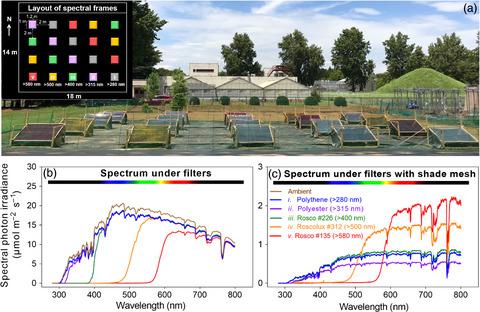Our official English website, www.x-mol.net, welcomes your
feedback! (Note: you will need to create a separate account there.)
Testing trait plasticity over the range of spectral composition of sunlight in forb species differing in shade tolerance
Journal of Ecology ( IF 5.3 ) Pub Date : 2020-03-04 , DOI: 10.1111/1365-2745.13384 Qing‐Wei Wang 1, 2 , Thomas Matthew Robson 3 , Marta Pieristè 3, 4 , Michio Oguro 1 , Riichi Oguchi 5 , Yoshinori Murai 6 , Hiroko Kurokawa 1
中文翻译:

在耐荫性不同的福布斯物种中,在太阳光谱组成范围内测试性状可塑性
更新日期:2020-03-04
Journal of Ecology ( IF 5.3 ) Pub Date : 2020-03-04 , DOI: 10.1111/1365-2745.13384 Qing‐Wei Wang 1, 2 , Thomas Matthew Robson 3 , Marta Pieristè 3, 4 , Michio Oguro 1 , Riichi Oguchi 5 , Yoshinori Murai 6 , Hiroko Kurokawa 1
Affiliation

|
- Although sunlight is essential for plant growth and development, the relative importance of each spectral region in shaping functional traits is poorly understood, particularly in dynamic light environments such as forest ecosystems.
- We examined responses of 25 functional traits from groups of 11 shade‐intolerant and 12 understorey shade‐tolerant forb species grown outdoors under five filter treatments differing in spectral transmittance: (a) transmitting c. 95% of solar radiation (280–800 nm); (b) attenuating ultraviolet‐B (UV‐B); (c) attenuating all UV; (d) attenuating all UV and blue light; (e) attenuating all UV, blue and green light.
- Our results show that UV‐B radiation mainly affected the biochemical traits but blue light mainly affected the physiological traits irrespective of functional strategy, whereas green light affected both sets of traits. This would suggest that differentiation among suites of functional trait responses proceeds according to light quality. Biomass accumulation was significantly increased by UV‐A radiation (contrasting treatment [b] vs. [c]) among shade‐intolerant but decreased by blue light among shade‐tolerant species; green and red light affected whole‐plant morphological development differently according to functional groups. Shade‐tolerant species were more plastic than shade‐intolerant species in response to each spectral region that we examined except for UV‐B radiation.
- Synthesis. Our results show that differences in the spectral composition of sunlight can drive functional trait expression irrespective of total irradiance received. The different responses of functional traits between functional groups imply that shade‐tolerant and intolerant species have adapted to utilize spectral cues differently in their respective light environments.
中文翻译:

在耐荫性不同的福布斯物种中,在太阳光谱组成范围内测试性状可塑性
- 尽管阳光对于植物的生长和发育至关重要,但人们对每个光谱区域在塑造功能性状方面的相对重要性了解甚少,尤其是在动态光照环境下,例如森林生态系统。
- 我们检查了在五种不同光谱透射率的滤光片处理下,在户外种植的11种耐荫性和12种下层耐荫性Forb物种对25种功能性状的响应:(a)透射c。95%的太阳辐射(280-800 nm);(b)减弱紫外线-B(UV-B);(c)减弱所有紫外线;(d)减弱所有紫外线和蓝光;(e)减弱所有紫外线,蓝光和绿光。
- 我们的结果表明,无论功能策略如何,UV-B辐射主要影响生化特性,但蓝光主要影响生理特性,而绿光则影响这两种特性。这表明功能特质响应套件之间的区别是根据光照质量进行的。在不耐荫的物种中,UV-A辐射(对比处理[b]对[c])显着增加了生物量积累,但在耐荫物种中,蓝光降低了生物量积累;绿灯和红灯根据功能组对整个植物形态发育的影响不同。在我们检查的每个光谱区域中,除UV-B辐射外,耐荫树种比耐荫树种更具塑性。
- 综合。我们的结果表明,与接收到的总辐照度无关,阳光光谱成分的差异可以驱动功能性状的表达。功能组之间功能性状的不同响应表明,耐荫性和不耐性物种已适应在各自的光照环境中不同地利用光谱线索。











































 京公网安备 11010802027423号
京公网安备 11010802027423号